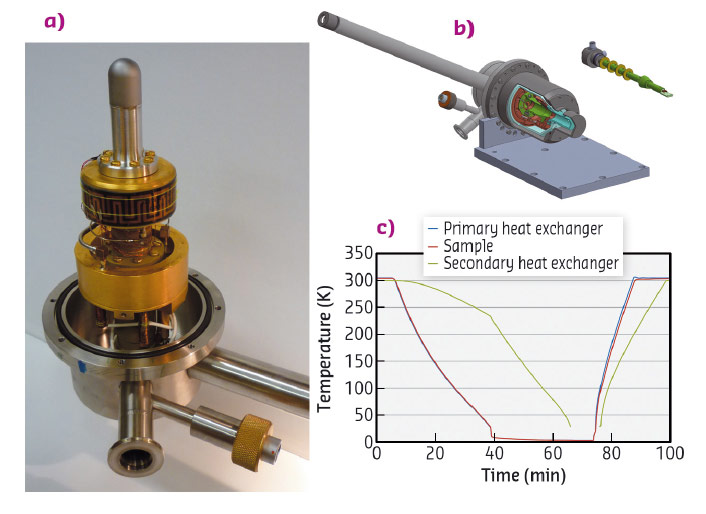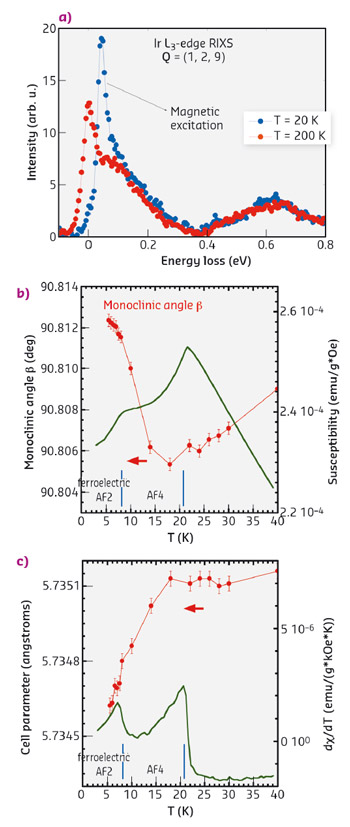DynaFlow cryostat
A new compact and versatile flow cryostat was developed for more efficient cooling of samples to very low temperatures. The cryostat can operate in any orientation, has large-angle optical access and quick sample change. The cryostat is in use at beamlines in three different synchrotrons.
Low temperature measurements at synchrotron radiation beamlines provide important data for materials science and physics on structural, magnetic and electronic material properties. Over the last few decades, a wide range of X-ray techniques has been developed for low temperature research. During this time, the continuously increasing brilliance of synchrotron radiation sources and the associated absorption of larger numbers of high-energy photons in the sample has rendered the cooling of samples to very low temperatures more difficult. By positioning the sample in exchange gas, sample cooling can be enhanced with respect to cryostats with the sample in vacuum in mechanical contact with the cold source. In the dynamic flow cryostat (DynaFlow) presented here, the sample is positioned in direct contact with a cooling flow of helium. The DynaFlow cryostat is of modular construction, is compact and offers a large-angle optical access. It operates from 325 kelvin down to below 3 kelvin; at minimum temperature the helium consumption is slightly above 2 litres per hour. Three cryostats have been built for beamlines ESRF ID20, ALBA BL04-MSPD and BL22-CLÆSS and for Diamond Light Source I-11.
 |
|
Fig. 160: DynaFlow overview. a) interior of the cryostat with copper heat exchangers and beryllium inner vacuum chamber; b) cut view of the cryostat with outer vacuum chamber mounted and sample holder; c) graph of the cryostat warmup and cooldown. |
The DynaFlow cryostat has a peculiar mixed construction in metal and plastic. Most of the outer envelope is constructed in stainless steel for high strength; the cryogenic interior construction is made of copper for the best thermal conductivity for the heat exchangers combined with Torlon®4203 polyamide-imide for high strength thermally isolating parts of low thermal expansion. The different elements of the interior construction (Figure 160a and b) form a central tube inside of which the sample holder is placed and through which the cooling helium flows. The inner and outer vacuum chambers are designed to suit the optical angles of the experiment. Cooling from room temperature to base temperature takes about 90 minutes (Figure 160c); warmup of the cryostat can be faster. To change the sample holder, the helium circulation pump is stopped and the helium circuit is brought up to ambient pressure. Replacement of the sample holder is then straightforward. After restarting the pump, a certain time is necessary to cool down the sample holder.
Two examples of experiments involving the DynaFlow cryostat follow. The first from ID20 reports the RIXS study of the magnetic excitations in CaIrO3, an antiferromagnetic insulator with post-Perovskite structure. In these experiments, it was necessary to lower the temperature below the Néel temperature of 110 K of CaIrO3 to observe magnetic excitations. The temperature dependence of the RIXS spectra for a momentum transfer of Q = (1,2,9) in Figure 161a shows the elastic line at zero energy loss to be much lower at low temperature; the peak at 0.04 eV and the broad distribution up to 0.3 eV are associated with the magnetic excitations. The almost temperature-independent broad distribution between 0.4 and 0.8 eV is associated with spin-orbital transitions. The influence of temperature is clearly visible in the RIXS response and can be directly linked to a change in physical properties of the system under study.
 |
|
Fig. 161: a) Temperature dependence of the RIXS spectra of CaIrO3. b) and c) Temperature dependence of the susceptibility and lattice parameters of Mn0.75Co0.25WO4. |
The second example from ALBA BL04-MSPD reports the case of powder diffraction on Mn0.75Co0.25WO4. Although the number of photons absorbed in the sample during a powder diffraction experiment is usually quite low, the thermalisation of the sample in a spinning glass capillary is not very good and the sample temperature may still rise significantly. It was thus questioned what could be the lowest attainable temperatures. The probed system is known to undergo successive magnetic transitions below 40 K. Data were collected in narrow temperature steps from 30 K down to 5 K. Selected unit cell parameters refined from the collected patterns are shown in Figure 161b and c together with magnetic susceptibility measurements which highlight the onset of magnetic transitions at 7 and 21 K. The reliability of data collection down to 5 K is evidenced by the match between the magnetic transition temperatures and structural parameter anomalies.
The DynaFlow cryostat is in routine operation at three different synchrotron research centres. The instrument has proven reliable and easily adaptable to different X-ray configurations in the tender to hard X-ray range. Its compact nature, the different accessible working geometries, the efficient and reliable sample cooling and fast sample changing are at the origin of its competitiveness with respect to existing cryostats in the market.
Principal publication and authors
A compact and versatile dynamic flow cryostat for photon science, P.J.E.M. van der Linden (a), M. Moretti Sala (a), C. Henriquet (a), M. Rossi (a), K. Ohgushi (b), F. Fauth (c), L. Simonelli (c), C. Marini (c), E. Fraga (c), C. Murray (d), J. Potter (d) and M. Krisch (a), Rev. Sci. Instrum. 87, 115103 (2016); doi: 10.1063/1.4966270.
(a) ESRF
(b) Department of Physics, Graduate School of Science, Tohoku University, Sendai (Japan)
(c) ALBA Synchrotron Light Source, Cerdanyola del Vallès, Barcelona (Spain)
(d) Diamond Light Source Ltd., Harwell Science and Innovation Campus, Didcot (U.K.)



